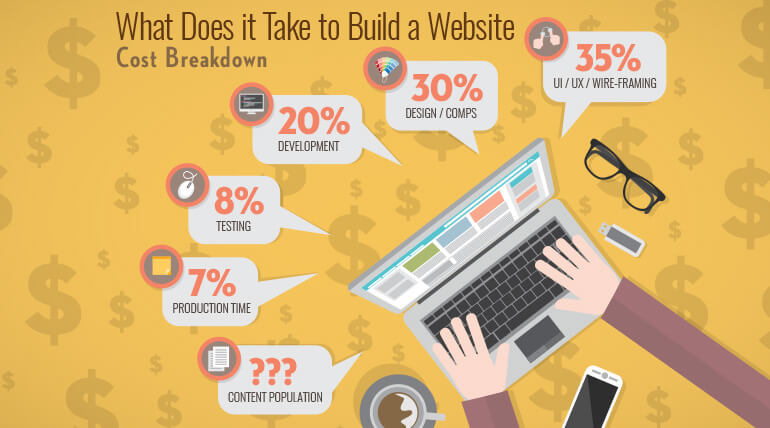Website Design and Development Costs: Custom versus Template
Have you ever gotten a website proposal from an agency and thought to yourself, “$30,000? Am I being punk’d?”
Professionals outside the design/development industry may not understand why a website can cost as much as a car. But, when you learn what comes with a modern custom website done by an experienced agency, it’s pretty easy to understand why it can cost upwards of $25,000 to $35,000.
Our senior front-end developer, Bradley Shilling, breaks down what you should expect with a template versus a custom site, some examples of designs to take inspiration from, and some insights on what type of design would be best for you.
What are you paying for? Different agencies have their own cost breakdowns of a custom site, and they usually change depending on the size and functionality of the site. In general, however, this is what you should expect.
Out-of-the-box Template
You should use a template if:
- You have a small budget. Many templates cost less than $100, and some are even free.
- You’re a start-up. Again, you won’t have to spend much money on a template, and at least you’ll have a good start until you’re ready to invest in something custom.
- You change your mind a lot. When you use templates, you have the ability to change the look of your website without losing a huge investment.
Why are templates so inexpensive? Because they have a lot of limitations.
It’s important that you are aware of what you can’t do before you begin using a template:
- Templates limit you from having lots of custom integrations.
- Many other people will be using the same template. Here are three websites that have the same theme.
- Less money = more problems (sometimes). Many templates use antiquated coding and don’t document their code. This can cause the site to display poorly on some browsers and devices, so you may have to hire a web developer to fix the template and get an eye-catching web design.
- Many templates are not search-engine friendly, adding to the frustration of SEO marketers and web developers.
- Because so many people use the same templates, hackers running computer programs looking for security vulnerabilities can quickly discover exploits.
Despite the limitations of templates, they are great for certain people and companies. If you have a small budget and just want to get your presence on the Internet before making a huge investment, template away! Just know that there’s a possibility of running into an SEO or security issue.
Customized by Agency
You should use a custom site if:
- Your company requires a lot of flexibility and integrations
- Your company has a need for custom web apps and server-side programming
- Your company has security requirements
- You want a unique design – if you go custom, rest assured that no one else will have the same design as you.
- You want SEO (face it, we all need SEO)
- You expect great user experience on all targeted browsers and devices
- You want clean, current code that is well documented
A custom site offers more flexibility and can be built on whatever content management system you desire. Custom sites can cost between several thousand dollars to well over a hundred thousand dollars, depending on the agency rates, size of site, amount of content, complexity of programming, and other variables. But, after looking at what goes into building a custom site versus using a template, you can see why they are so expensive.
UI/UX/Wireframing: Approximately 35% of time spent on a website is dedicated to developing the structure, interface and user experience. These considerations are essential to every step of the design and development process. More about the way web design is done, read DFY White Label Web Design – Wholesale Websites – The Digital Swarm.
Design/Comps: The design portion of the project determines the look and feel of the final website. In the past, clients were provided with static comps to review; however, with the rise in popularity of mobile devices and responsive design, many designers are now opting to design directly in a browser. This approach not only saves time but also provides clients with an interactive prototype to review.
Development: The development phase of a project is where the magic happens. The prototype/design comp is handed off from the designer to the developer. During development, the design is hooked into a Content Management System and databases are configured. This is also the phase when the website’s functionality is built out.
Testing: During the testing phase of a project, a site is checked in multiple browsers and devices to make sure the user experience is consistent across all platforms. This is also the phase of the project when bugs are squashed and the site is optimized to ensure minimum load times.
Production Time: Production time includes discovery, research, meetings, brainstorming and communications.
Content population: The time and cost required for content population is dependent upon the site being developed. Some clients prefer to handle content population on their end and others require copywriting and content development. Some sites only have five pages of content and others have hundreds of pages of content to migrate.
Sutter Group has done custom sites for $12,000 up to $150,000, and everything in between. The cost range can vary widely based on the scope of work needed. Oftentimes, business owners and marketing departments will want to have a consultation call with an agency first. Agencies can also offer ideas for what can/should go into a website that businesses might not have thought of originally. Hiring https://www.duxdigital.com.au/ to help you with your website can help you attract more customers.
Now, go decide what’s best for your company and modernize your presence on the Web!






